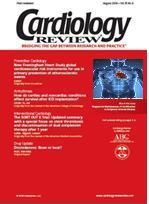Publication
Article
Cardiology Review® Online
Higher clopidogrel maintenance dosage in a patient undergoing percutaneous coronary intervention
A 56-year-old man with type 2 diabetes mellitus, hypertension, and tobacco dependence presented to the emergency department with a 3-hour history of "crushing" substernal chest pain.
A 56-year-old man with type 2 diabetes mellitus, hypertension, and tobacco dependence presented to the emergency department with a 3-hour history of "crushing" substernal chest pain. He was receiving treatment with aspirin, an angiotensin-converting enzyme (ACE) inhibitor, and a sulfonylurea. In the emergency department, the electrocardiogram showed ≥ 2 mm ST-segment depression in leads V2-V6, I, and aVL. A left-sided heart catheterization revealed a severe stenosis proximal to mid-left anterior descending artery (LAD), a totally occluded dominant right coronary artery, and a totally occluded left circumflex artery. Surgical revascularization was recommended, but this was refused by the patient. Therefore, percutaneous coronary revascularization was scheduled.
µ
Before performing the interventional procedure, the patient was informed of the importance of adhering to his antiplatelet treatment, in particular, clopidogrel (Plavix) therapy. He was informed of the potential risk of developing stent thrombosis and of its catastrophic consequences if he was not adherent to antiplatelet therapy. Given that the patient was at high risk for stent thrombosis because of his diabetes and the need for multiple overlapping drug-eluting stents to treat his long stenosis in the LAD, which represented the last patent major coronary artery, blood samples were taken to analyze the status of his platelet aggregation. Platelet aggregation was tested with light transmission aggregometry using 20 mol/L adenosine diphosphate stimuli. Platelet aggregation was performed before clopidogrel administration and at discharge.
The patient underwent percutaneous coronary intervention 6 hours after pretreatment with 600 mg of clopidogrel. The LAD lesion was successfully treated using 2 long, 3.5 x 33-mm, overlapping drug-eluting stents. A good angiographic result was obtained. The patient continued treatment with aspirin, a beta blocker, an ACE inhibitor, a statin, a sulfonylurea, and clopidogrel. After 48 hours, the patient was prepared for discharge, and his platelet function was again assessed.
The degree of maximal platelet aggregation before and after clopidogrel administration was 90% and 72%, respectively. The degree of inhibition of platelet aggregation (IPA) was 20%. Given the low degree of platelet inhibition and the persistence of elevated platelet reactivity using a standard dose of clopidogrel (75 mg), the maintenance dose was increased to 150/mg day. At the patient's 1-month follow-up visit, he was asymptomatic and had a degree of maximal platelet aggregation of 40% (thus, an IPA of 55.5%). He did not develop any bleeding complications.






